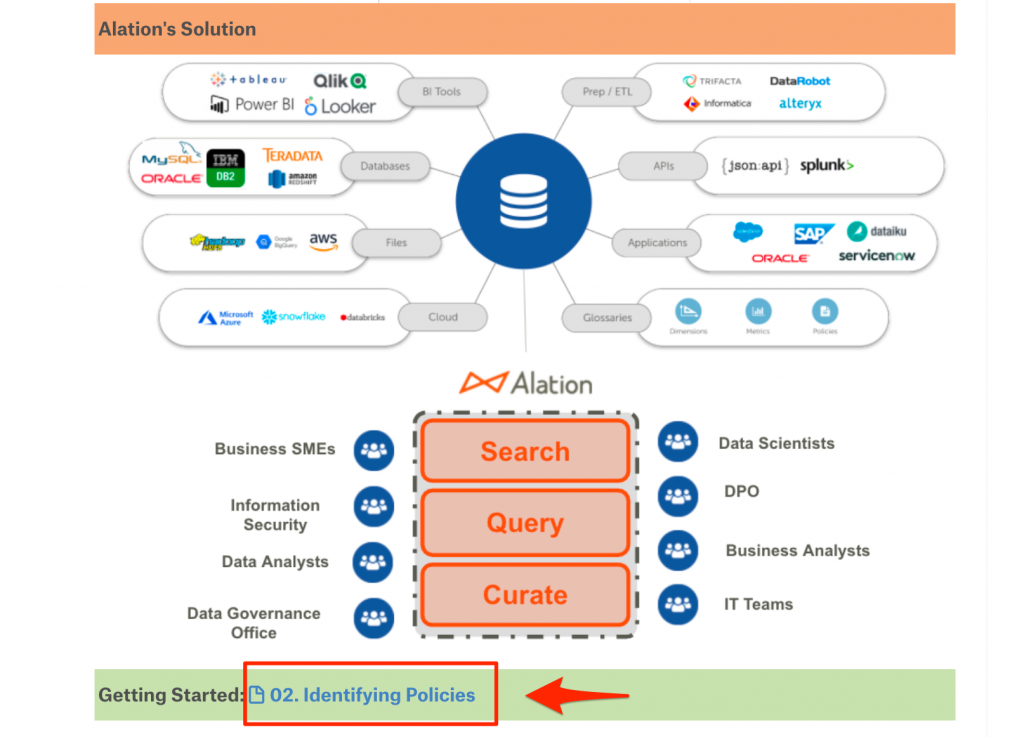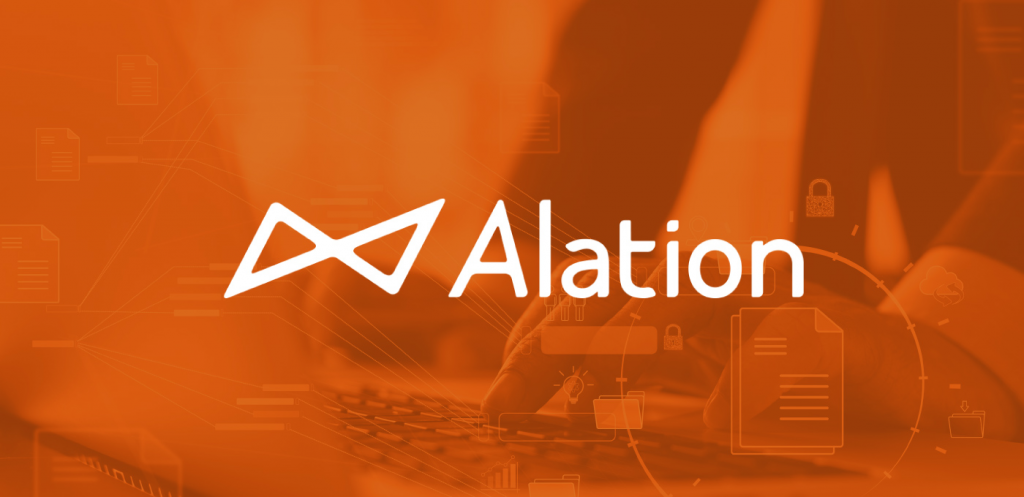What is Alation?

Alation is a data catalog and data intelligence platform that helps organizations discover, understand, and govern their data assets effectively. It provides a collaborative environment for data analysts, data stewards, and business users to find, document, and analyze data. Alation uses machine learning and natural language processing (NLP) to automate data discovery and provide data intelligence, making it easier for users to make data-driven decisions and ensure data governance.
Top 10 use cases of Alation:
- Data Cataloging: Create a centralized and searchable data catalog to discover and access data assets across the organization.
- Data Governance: Establish data governance policies, standards, and workflows for data management and compliance.
- Data Lineage: Track data lineage to understand the origins and transformations of data.
- Data Collaboration: Facilitate collaboration between data analysts, data stewards, and business users for better data understanding.
- Data Profiling and Quality Management: Use data profiling to assess data quality and identify data issues.
- Data Stewardship: Assign and manage data stewardship tasks and responsibilities.
- Data Insights and Reporting: Provide data insights and reporting for data governance metrics and KPIs.
- Data Privacy and Security: Control data access, privacy, and security to comply with regulations.
- Data Usage and Impact Analysis: Track data usage and perform impact analysis on data changes.
- Data Democratization: Empower business users with self-service access to trusted and governed data.
What are the feature of Alation?

- Data Catalog: Provides a centralized and searchable data catalog with metadata management capabilities.
- Data Governance: Enables data governance workflows, data stewardship, and data governance policies.
- Data Lineage: Visualizes data lineage to track data origins and transformations.
- Data Profiling and Quality Management: Performs data profiling and data quality assessments.
- Collaboration: Facilitates collaboration and knowledge sharing among data users.
- Data Usage Tracking: Tracks data usage to understand how data is being used.
- Smart Suggestions: Offers smart suggestions using machine learning and NLP to assist users.
- Security and Access Control: Provides data access control and security features.
- Business Glossary: Allows users to maintain a business glossary to define and standardize data terms.
- Integrations: Integrates with various data sources, BI tools, and data platforms.
How Alation works and Architecture?

Alation works as a centralized web-based platform that integrates with various data sources, data platforms, and BI tools. It uses machine learning and NLP to automate data discovery, data cataloging, and data intelligence. The platform is designed to be collaborative and user-friendly, allowing data users to easily find, understand, and govern data assets.
The architecture of Alation involves the following components:
- Data Connectors: Alation provides connectors to integrate with various data sources and platforms, such as databases, data lakes, cloud storage, and BI tools.
- Metadata Management: Alation collects and manages metadata from connected data sources to build the data catalog.
- Machine Learning and NLP: Alation uses machine learning and natural language processing to automate data discovery, suggestions, and data intelligence.
- User Interface: Alation offers a web-based user interface that allows users to search, explore, and collaborate on data assets.
- Data Governance: Alation supports data governance workflows and data stewardship features for data governance and compliance.
How to Install Alation?
Alation is a commercial data catalog platform, and its installation process typically involves working closely with Alation’s sales or support team to set up and configure the platform according to your organization’s requirements. Since Alation is typically used in large enterprise environments, the installation and configuration process can be more complex and tailored to specific environments.
To get started with Alation, consider these general steps:
- Contact Alation: Reach out to Alation’s sales or support team to discuss your requirements and obtain the necessary licenses and installation support.
- System Requirements: Review the system requirements and hardware specifications provided by Alation for your specific version.
- Installation and Configuration: Work closely with Alation’s professional services or support team to install and configure Alation according to your organization’s needs.
- Integration: Integrate Alation with your existing data sources, data platforms, and BI tools.
- User Training: Provide training to your data users and data governance teams to ensure effective adoption and utilization of Alation’s features.
Since the installation process can be complex and tailored to specific environments, it is best to work closely with Alation’s professional services or support team to ensure a successful deployment of the platform.
Basic Tutorials of Alation: Getting Started
Here, Let’s have a look at the key steps to get started with Alation’s Data Catalog and basic functionalities.

Step-by-Step Basic Tutorial of Alation Data Catalog:
Step 1: Obtain Alation Data Catalog
- Contact Alation’s sales team to obtain the necessary licenses and access to Alation Data Catalog.
Step 2: Install and Configure Alation Data Catalog
- Review the system requirements and hardware specifications provided by Alation for your specific version.
- Work closely with Alation’s support team to install and configure Alation Data Catalog based on your organization’s needs.
Step 3: Set Up User Authentication and Access Control
- Configure user authentication to control access to Alation Data Catalog.
- Set up user roles and permissions based on organizational roles and responsibilities.
Step 4: Connect Data Sources to Alation Data Catalog
- Connect Alation Data Catalog to various data sources, such as databases, data lakes, cloud storage, and BI tools.
- Configure data source connectors and metadata collection.
Step 5: Discover and Catalog Data Assets
- Utilize Alation’s data discovery capabilities to automatically catalog data assets.
- Add additional metadata, such as descriptions and business glossary terms, to enhance data understanding.
Step 6: Search and Explore Data Assets
- Use the Alation Data Catalog web interface to search and explore data assets.
- Utilize search filters and tags to refine search results.
Step 7: View Data Lineage and Impact Analysis
- Visualize data lineage to understand data origins and transformations.
- Perform impact analysis to assess the impact of changes to data assets.
Step 8: Collaborate and Share Knowledge
- Encourage collaboration between data users by leaving comments and annotations on data assets.
- Share knowledge and insights about data assets within Alation Data Catalog.
Step 9: Utilize Data Insights and Suggestions
- Leverage Alation’s machine learning and natural language processing to get smart suggestions and recommendations related to data assets.
- Utilize data insights and analytics provided by Alation.
Step 10: Monitor Data Usage and Governance Metrics
- Monitor data usage statistics to understand how data assets are being used.
- Track data governance metrics and key performance indicators (KPIs).
Alation is a powerful platform with many advanced features and functionalities, and the actual implementation process can be more involved and tailored to specific organizational needs.
For a more detailed and comprehensive tutorial, I recommend referring to Alation’s official documentation, and training materials.
- Why Can’t I Make Create A New Folder on External Drive on Mac – Solved - April 28, 2024
- Tips on How to Become a DevOps Engineer - April 28, 2024
- Computer Programming Education Requirements – What You Need to Know - April 28, 2024

